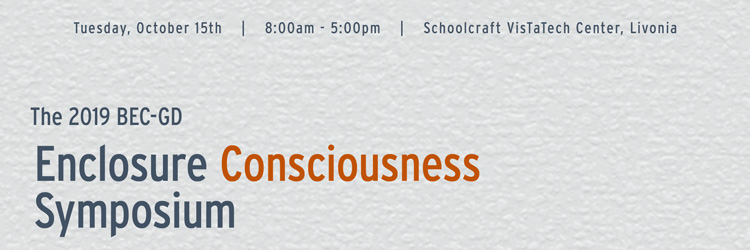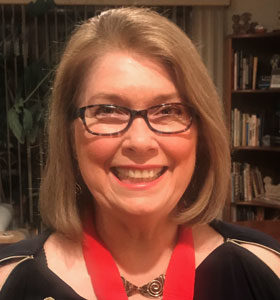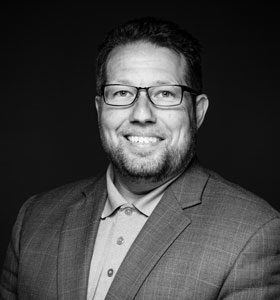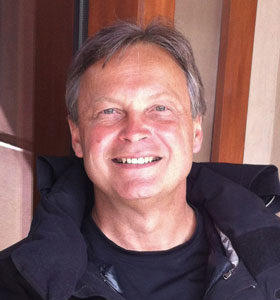
Date: October 15, 2019 | Time: 8:00am - 5:00pm - Up to 6.5 Continuing Educational Credits
BEC-GD Enclosure Consciousness 2019: Presentation & Speaker Info
The Building Enclosure Council of Greater Detroit is proud celebrate their Annual Symposium with you. Every year, the BEC-GD symposium presents a distinguished panel of speakers to discuss the current and upcoming trends in building enclosure performance and evaluation.
The event includes a continental breakfast, lunch, and snacks. As in previous years, there will be a Continuing Education Credits and raffle for prizes for attendees who visit all of the vendors and obtain a signature from each.
REGISTER HERE
Up to 6.5 AIA HSW Continuing Education Credits will be provided
AGENDA:
8:00am-8:30am – Check-in, Continental Breakfast, and Sponsor Displays
8:30am-9:00am – Opening Comments | Betsy Baird, AIA, 2019 BEC-GD Chair
9:00am-10:15am – Presentation by Janice Means, PE, LEED AP, FESD
10:15am-10:45am – Morning Break, Sponsor Displays, Sponsor Announcements
10:45am-12:00pm – Presentation by Roy Schauffele, FCSI, CCPR, FABAA, LEED GA, CABS
12:00pm-1:30pm – Lunch Break, Sponsor Displays, Sponsor Announcements
1:30pm-2:45pm – Presentation by Jeff Diqui
2:45pm-3:15pm – Afternoon Break, Sponsor Displays, Sponsor Announcements
3:15pm-4:45pm – Presentation by Joseph Lstiburek, Ph.D., P.Eng., ASHRAE Fellow
4:45pm Closing Remarks and Door Prizes
PRESENTATIONS:
Envelope Recommendations from ASHRAE Guideline 34-2019 – Energy Guideline for Historic Buildings
Janice K. Means, PE, LEED AP, FESD | Professor Emeritus, LTU College of Architecture and Design
ABSTRACT
This presentation gives an overview of the newly-issued ASHRAE 34 guideline which provides direction on addressing the unique issues associated with making historic buildings more energy conserving. Guideline 34 was developed by a relatively small, but internationally- and discipline-diverse ASHRAE committee of which the presenter was a voting member. Attendees will be introduced to the guideline with emphasis on the sections specifically addressing the building envelope. It is emphasized that the developers went to great lengths to respect and preserve historic architecture and associated artifacts while striving to optimize the buildings’ energy efficiency and occupant comfort.
LEARNING OBJECTIVES
• Understand that a new guideline for energy efficiency of historic buildings is now available through ASHRAE
• Describe the intended users of the guideline, recognizing that it isn’t just for engineers.
• Recognize that this new guideline is written and intended to be used internationally.
• Although the guideline specifically addresses listed historic buildings, many of its recommendations can be applied to non-listed historic buildings.
The Importance of Wall to Roof Connections for the Air Barrier – the Big Disconnect
Roy F. Schauffele, FCSI, CCPR, FABAA, LEED GA, CABS | Founder of Division 7 Solutions, Inc.
ABSTRACT
As more states, jurisdictions and the design community require air barriers, the issue of connecting the wall air barrier assembly to other building assemblies, such as below grade, window systems and roofs need to be completely understood in order to design and construct a functioning building enclosure.
One of the most often missed or not well executed details is the connection between the wall air barrier and roof assembly. With a myriad of roof systems, wall configurations and the growing number of wall air barrier products, it can be difficult to navigate the process in regards to what systems work best with each other and the chemical compatibility of these systems.
This presentation will focus on things to consider from a design standpoint, along with practical approaches to ensuring a robust connection is constructed and executed.
LEARNING OBJECTIVES
• Understand why the roof/wall air barrier intersection is critical to building performance in regards to moisture management and air leakage control and common design and field errors.
• Become aware of compatibility issues related to wall and roof air barrier components for the myriad of air barrier and roofing assemblies that exist on the market today.
• Identify pre-construction coordination items to review and allocation of responsibilities to sub-trades for proper execution of connection.
• Review requirements for detailing the roof/wall interface and the sequence of construction for most common roof/wall air barrier connections.
Masonry Flashing & Moisture Control
Jeff Diqui | Director of Technical Services at International Masonry Institute
ABSTRACT
This course defines best practice for design and construction of moisture management systems for masonry cavity and veneer wall systems. Code requirements, system components, workmanship and key details will discussed. Key details include: base-of-wall, sills, heads, shelf angles, roof-to-wall interface, kick-outs, louvers and top-of-wall.
LEARNING OBJECTIVES
• Learn basic moisture control strategies for masonry walls.
• Understand the multi-purposes of masonry flashing.
• Acquire proven methods to design and detail flashing systems.
• Develop an appreciation for quality flashing installations.
Venting and Non-Venting Roof Assemblies
Joseph Lstiburek, Ph.D., P.Eng., ASHRAE Fellow | Principal at Building Science Corporation
ABSTRACT
Michigan has the same laws of physics as everyone else but a varied climate. Detroit is not Houston. This session addresses how to construct vented and unvented flat roofs, cathedral roofs and attic assemblies in Michigan…based on lessons from Atlanta to Aspen and Boston to Seattle.
LEARNING OBJECTIVES
• Understanding control of condensing surface temperatures in unvented roof construction.
• Understanding control of ice damming in vented and unvented roof construction.
• Understanding material choices in hybrid roof assemblies.
• Understanding why an R-100 roof can be the lowest cost assembly.
SPEAKER BIOS:
 Janice K. Means, PE, LEED AP, FESD
Janice K. Means, PE, LEED AP, FESD
Janice Means, PE, LEED AP, FESD, Professor Emeritus, College of Architecture and Design, Lawrence Technological University, in Southfield, Michigan, has diverse experience in in industry, engineering consulting and higher education.
Ms. Means has served as an active member of ASHRAE since 1985 in several leadership positions at the local, regional and international levels. Locally, she served as the Detroit Chapter President, Secretary, Chair of Student Activities, Chair of Technical and Governmental Activities, Chapter Historian and a 9-year term on the Board of Governors. Regionally, she was the Region V Vice Chair of Student Activities. At the ASHRAE society (international) level, she is a trained presenter for the energy standard, ANSI/ASHRAE/IESNA Std. 90.1, a member of 3 technical committees (Building Environmental Impacts & Sustainability, Solar & Other Renewable Energies and Climate Change). Professor Means served 3 years as Chair of the Solar Energy Utilization Technical Committee, 3 years on the Student Activities Standing Committee and has just begun a 3-year term on the Scholarship Trustee Standing Committee. Ms. Means also served on the GPC 34 Committee which developed a new guideline for Energy Efficiency in Historic Buildings. She is co-editor of the 4th and 5th editions of ASHRAE GreenGuide: Design, Construction & Operation of Sustainable Buildings and was a contributing author to Chapter 36 in the 2008 ASHRAE HVAC Systems and Equipment Handbook.
Professor Means’ students were awarded an ASHRAE Senior Grant in 2008-2009 and placed 1st in ASHRAE’s international Student Design Competition in 2004. She has continued to mentor students in the ASHRAE Student Design Competitions, who now have placed 1st, 2nd or 3rd internationally 9 out of the 11 years of submission.
Ms. Means is past Chair of the Engineering Society of Detroit’s Affiliate Council and a past board member of the Michigan Interfaith Power & Light and the Michigan Solar Energy Association.
Professor Means has coordinated/taught architecture and architectural engineering environmental courses (HVAC, Electricity, Acoustics, Illumination, High Performance Buildings, Active Solar Design and Passive Solar Design), has presented papers internationally and contributed to grants including Michigan’s Vital Signs and 10kW Photovoltaic, EPA’s 3P, and NREL’s Solar Decathlon. Ms. Means has also organized several statewide and local sustainability and solar energy conferences.
Ms. Means holds 2 undergraduate degrees from Oakland University in Rochester, Michigan and a Masters Degree in Mechanical Engineering from the University of Michigan. She is a Fellow in the Engineering Society of Detroit (ESD), a Michigan Registered Professional Engineer, a LEED Accredited Professional and has earned multiple distinguished service awards at the local level from ESD and at the local, regional and international level from ASHRAE. On February 1, 2020, she will accept the E.K. Campbell Award of Merit for Outstanding Teaching and Service at the ASHRAE International Winter Conference in Orlando, Forida.
 Roy Schauffele, FCSI, CCPR, FABAA, LEED Green Associate, CABS
Roy Schauffele, FCSI, CCPR, FABAA, LEED Green Associate, CABS
Schauffele is a thirty-year member of CSI, an internationally published author and speaker in the fields of energy conservation and sustainable building envelopes including insulation, air barrier technology, roofing & waterproofing, vegetative & cool roofing, all with an eye towards improving building science, performance and quality of life.
He currently serves as an Executive Committee Member for the ABAA (Air Barrier Association of America) Past Board Chairman of the ABAA, after 3 terms as Chairman. Currently a Technical Advisor to Build San Antonio Green (BSAG) and an award winner 2012 for his Technical Contributions to BSAG and last year named (2016) Individual Green Practitioner by the City of San Antonio for Sustainable Education and Outreach.
Globally, he is the only person to be a Fellow of both CSI and ABAA, also he is the 1st Certified Air Barrier Specialist (CABS). His profile is on LinkedIn.
He continues to be a requested national speaker on all Division 7 topics especially air barriers, building envelope design, waterproofing, energy conservation and sustainability.
 Jeff Diqui
Jeff Diqui
Mr. Diqui, holds a Bachelor of Science Degree in Architectural Engineering with a major in Structural Engineering from Milwaukee School of Engineering. He has more than 25 years of experience that has been focused on the building enclosure. Experience has included forensic investigations related to moisture intrusion and structural related problems, structural design, building condition assessments, development of repair / rehabilitation designs, and construction observations. For over a decade, Jeff has been a frequent lecturer nationally to architects, engineers, specifiers, building envelope consultants, contractors, and code officials on subject matter pertaining to the importance of maintaining continuity of air, water, vapor, and thermal controls of the enclosure and the ever-important interface detail. Jeff is actively involved with the building science and architectural / engineering professions. He is Program Director for the Building Enclosure Council (BEC) – Chicago Chapter, Technical Roundtable Committee Member of the Construction Specifications Institute (CSI) – Chicago Chapter, and Terminations & Flashings Committee Member of the Air Barrier Association of America (ABAA).
 Joseph Lstiburek, Ph.D., P.Eng., ASHRAE Fellow
Joseph Lstiburek, Ph.D., P.Eng., ASHRAE Fellow
Joseph Lstiburek is a principal of Building Science Corporation. Dr. Lstiburek’s work at BSC ranges widely, from investigating building failures to overseeing research and development projects, to writing articles and books as well as educating industry professionals. A building science pioneer, particularly in the areas of air barriers, vapor barriers, and vented and unvented assemblies, he has had a lasting impact on building codes and practices throughout the world. Dr. Lstiburek founded BSC in 1991, and has been a key figure in establishing it as one of the most influential and respected building science firms in North America.
Dr. Lstiburek has been a licensed Professional Engineer in the Province of Ontario since 1982 and is an ASHRAE Fellow. He is an Adjunct Professor of Civil Engineering at the University of Toronto and the past chairman of ASTM E241 – Increasing the Durability of Building Assemblies from Moisture Induced Damage. He also worked on the Canada-wide Super Energy Efficient Housing R-2000 program and served as senior engineer on commercial construction projects for Trow in Toronto. Dr. Lstiburek is also a former Director of Research of the Housing and Urban Development Association of Canada.
Dr. Lstiburek is one of the world’s foremost authorities on energy efficient construction techniques and heads one of the Building America program teams for the U.S. Department of Energy. Through the program, Dr. Lstiburek has forged partnerships with designers, builders, developers, materials suppliers and equipment manufacturers to build higher performance buildings across the U.S.
Dr. Lstiburek is a noted educator who has taught hundreds of professionals over the past three decades. He has written numerous books and technical papers on building science, indoor air quality and durability, such as the best-selling Builder’s Guides and the U.S. DOE Handbook on Moisture Control. Fittingly, the Wall Street Journal has described him as “the dean of North American building science.”
